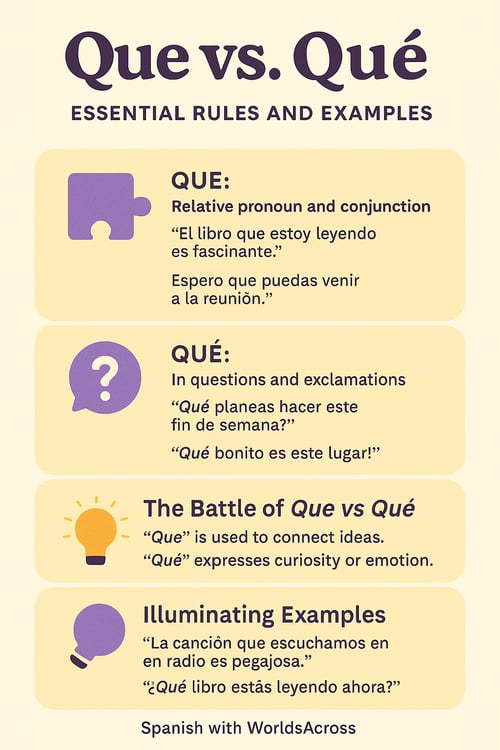Que vs Qué in Spanish: Essential Rules and Examples
How can an accent mark, that simple little line, make such a big difference in Spanish? At first glance, "que" and "qué" may seem almost identical, but in reality, the accent mark makes all the difference between a connector and a spark of curiosity! Let’s dive into the differences between que vs qué in Spanish.
What do you think are the uses of que and qué in Spanish?
¿"Qué" is "Que"?
When it comes to connecting ideas and giving flow to our sentences, "que" is your best ally. Think of "que" as the glue that holds different parts of a sentence together, allowing your message to be expressed clearly and coherently. Let’s see how it’s used:
"Que": Relative Pronoun and Connector
In Spanish, "que" acts as a connector that links a main sentence to a subordinate one, providing more information to the main sentence.
Examples:
- El libro que estoy leyendo es fascinante.
- La casa que compramos está en la playa.
Here, "que" acts as the bridge that connects ideas and provides additional details. It’s a key piece in sentence structure—making everything fit!
Conjunction: The Essential Link
As a conjunction, "que" introduces subordinate clauses that complete the idea expressed in the main sentence, adding depth to communication.
Examples:
- Espero que puedas venir a la reunión.
- No sabía que te gustaban las películas de terror.
In these examples, "que" helps build a complete and fluid narrative. It’s the invisible thread that ties your thoughts together and makes them understandable.
And "Qué"?
Now, let’s talk about its counterpart: "qué." This term adds questions and exclamations to your conversations, bringing that touch of excitement and curiosity.
In Questions: Sparks Curiosity
When you need to know something, "qué" is your perfect tool. It’s the word that opens the door to new answers and discoveries.
Examples:
- ¿Qué planeas hacer este fin de semana?
- No sé qué pensar de la nueva película.
Here, "qué" becomes the center of attention, seeking answers and sparking curiosity.
In Exclamations: Express Your Emotions
"Qué" also shines in exclamations, where it captures the intensity of your emotions and expresses them vibrantly.
Examples:
- ¡Qué bonito es este lugar!
- ¡Qué sorpresa verte aquí!
In these cases, "qué" helps convey astonishment and admiration, making your feelings more expressive and clear.
The Battle of Que vs Qué in Spanish
To avoid confusion and mistakes, it’s essential to know the differences between que and qué. Here’s a quick summary:
- "Que" is used as a relative pronoun or conjunction to connect ideas and provide additional information.
- "Qué" is used in questions and exclamations to express curiosity or emotion.
These distinctions are key to understanding the differences between que vs qué in Spanish and effectively mastering their uses.
Illuminating Examples
To illustrate further, here are some additional examples to shed light on this battle between que vs qué in Spanish:
- "Que" in action: La canción que escuchamos en la radio es pegajosa.
- "Qué" in a question: "Qué" en una pregunta: ¿Qué libro estás leyendo ahora?
- "Qué" in an exclamation: ¡Qué increíble fue ese concierto!

These examples clearly show the different roles of this word. We hope they help you confidently master que vs qué in Spanish. The uses of que and qué become clear when practiced and well understood.
Understanding this is not just about grammar; it’s an opportunity to enrich your expression in Spanish. Every accent mark, every word, plays an essential role in how you communicate and how others understand you.
So, keep exploring and perfecting your Spanish. Every little detail counts. At WorldsAcross, we’re always here to support you in every step of your learning journey, giving you the tools you need to become the best at speaking Spanish.


